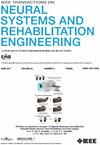Test-Retest Reliability of ERP and Auditory Steady State Response in Patients With Disorders of Consciousness
IF 4.8
2区 医学
Q2 ENGINEERING, BIOMEDICAL
IEEE Transactions on Neural Systems and Rehabilitation Engineering
Pub Date : 2025-04-15
DOI:10.1109/TNSRE.2025.3554536
引用次数: 0
Abstract
To identify the optimal auditory evoked strategy for assessing the level of consciousness in patients with disorders of consciousness (DoC) based on event related potentials (ERP) and amplitude modulation auditory steady state response (ASSR) and its test-retest reliability, this study conducted calling names and pure tone ERP evocations, as well as amplitude-modulated ASSR evocations with 440 Hz, 1000 Hz, and 2000 Hz carrier frequencies, in recruited prolonged DoC patients. The results showed that the MMN amplitude (P<0.05) and P300 (P<0.001) of calling names was higher than that of pure tones, while the P300 latency (P<0.05) was shorter. Compared to 1000 Hz and 2000 Hz, the ASSR of 440 Hz carrier frequency exhibited more pronounced early ERSP components (P=0.001), late ERSP components (P=0.011), early ITPC components (P=0.005), and late ITPC components (P=0.008). Significant differences were observed between minimally conscious state (MCS) and vegetative state (VS) patients in P300 amplitude, MMN amplitude, P300 latency, early ERSP component, late ERSP component, and early ITPC component. P300 amplitude (MCS: ICC=0.783; VS: ICC=0.750) and early ERSP component (MCS: ICC=0.780; VS: 0.759) had excellent test-retest reliability. Correlation analysis with the CRS-R scale indicated significant positive correlations between CRS-R scores and P300 amplitude (MCS: r=0.74; VS: r=0.60), early ERSP component (MCS: r=0.72; VS: r=0.52), and early ITPC component (MCS: r=0.71; VS: r=0.49) in both MCS and VS patients. The P300 amplitude and the early ERSP component of ASSR are reliable indicators that may complement each other in assessing the patients’ level of consciousness.意识障碍患者ERP和听觉稳态反应的重测信度
为了确定基于事件相关电位(ERP)和调幅听觉稳态反应(ASSR)及其重测信度评估意识障碍(DoC)患者意识水平的最佳听觉诱发策略,本研究在招募的延长期DoC患者中进行了呼叫、纯音ERP诱发以及440 Hz、1000 Hz和2000 Hz载波频率的调幅ASSR诱发。结果表明,骂人的MMN振幅(P<0.05)和P300 (P<0.001)均高于纯音,P300潜伏期(P<0.05)较短。与1000 Hz和2000 Hz相比,440 Hz载波频率的ASSR表现出更明显的早期ERSP分量(P=0.001)、晚期ERSP分量(P=0.011)、早期ITPC分量(P=0.005)和晚期ITPC分量(P=0.008)。最低意识状态(MCS)和植物人状态(VS)患者在P300振幅、MMN振幅、P300潜伏期、早期ERSP成分、晚期ERSP成分和早期ITPC成分方面存在显著差异。P300振幅(MCS: ICC=0.783;VS: ICC=0.750)和早期ERSP成分(MCS: ICC=0.780;VS: 0.759)具有极好的重测信度。与CRS-R量表的相关分析显示,CRS-R评分与P300振幅呈显著正相关(MCS: r=0.74;VS: r=0.60),早期ERSP成分(MCS: r=0.72;VS: r=0.52),早期ITPC成分(MCS: r=0.71;VS: r=0.49)。P300振幅和早期ERSP分量是评估患者意识水平的可靠指标,可以相互补充。
本文章由计算机程序翻译,如有差异,请以英文原文为准。
求助全文
约1分钟内获得全文
求助全文
来源期刊
CiteScore
8.60
自引率
8.20%
发文量
479
审稿时长
6-12 weeks
期刊介绍:
Rehabilitative and neural aspects of biomedical engineering, including functional electrical stimulation, acoustic dynamics, human performance measurement and analysis, nerve stimulation, electromyography, motor control and stimulation; and hardware and software applications for rehabilitation engineering and assistive devices.

 求助内容:
求助内容: 应助结果提醒方式:
应助结果提醒方式:


